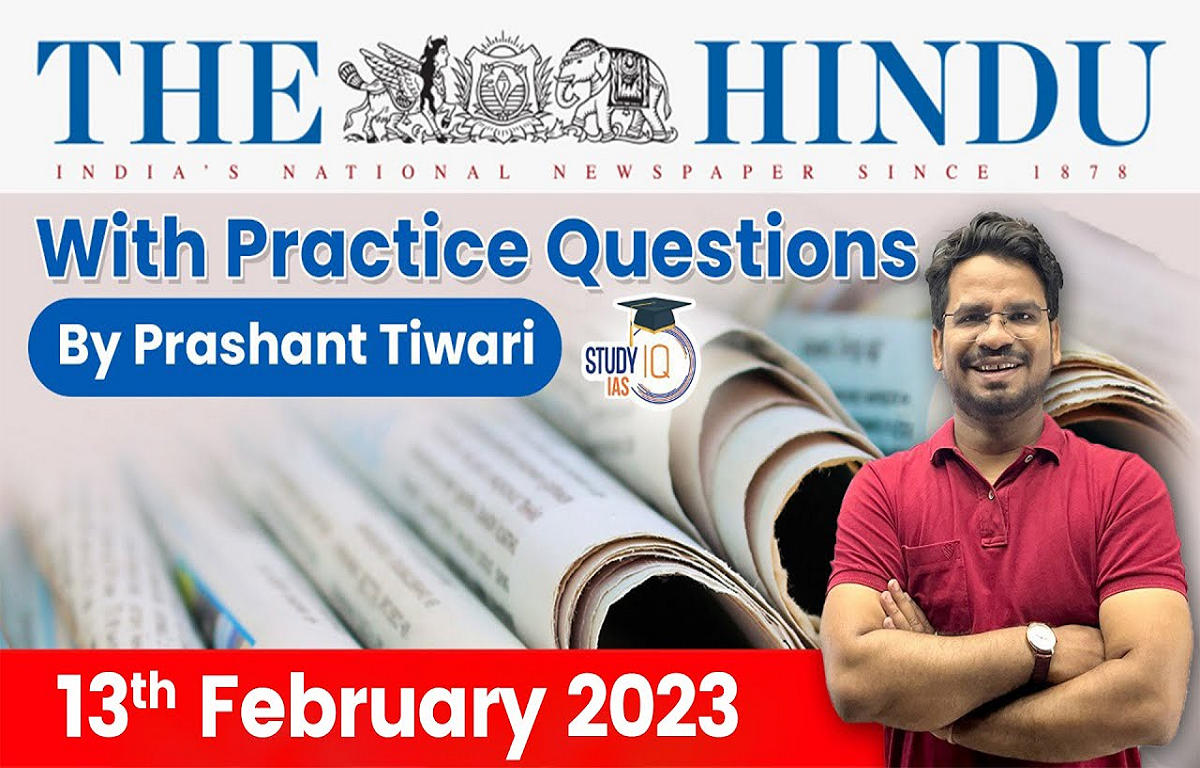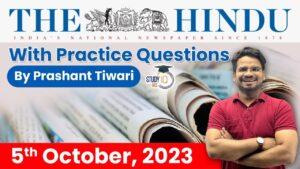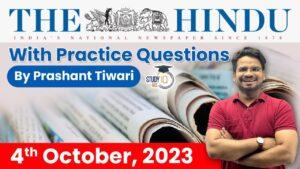The Hindu Newspaper Analysis for UPSC

The Hindu Newspaper Analysis 11 February 2023

- Former Supreme Court judge Justice S. Abdul Nazeer (retd) is among the six new faces appointed Governors by President Droupadi Murmu on Sunday.
- The President also accepted the resignations of Maharashtra Governor Bhagat Singh Koshyari and Ladakh Lieutenant-Governor R.K. Mathur in the latest gubernatorial reshuffle.
- Justice Nazeer (retd), who was part of the five-judge Bench that delivered the November 2019 Ayodhyaverdict, has been appointed Governor of Andhra Pradesh, while the incumbent, Biswa Bhushan Harichandan, has been moved to the Chhattisgarh Raj Bhavan.
- The former judge, who also headed the five-judge Constitution Bench that upheld the Union government’s November 2016 decision to demonetise ₹500 and ₹1000 currency notes, retired in January.
About Governor
- He/she is the Chief Executive Head of a State.
- Like the President of India, he is a nominal (titular or constitutional) head and also acts as an agent of the central government. Therefore, the office of governor has a dual role.
- Articles 153 to 167 in Part VI of the Constitution deal with the State Executive, which comprises the Governor, the Chief Minister, the Council of Ministers and the Advocate General of the State.
- There is no office of Vice-Governor (in the state) like that of Vice-President at the Centre.
- Usually, there is a governor for each state, however, the 7th Constitutional Amendment Act, 1956 facilitated the appointment of the same person as a governor for two or more states.
Appointment
- The Governor is neither directly elected by the people nor indirectly elected by a specially constituted electoral college as is the case with the President.
- He/she is appointed by the President by warrant under his hand and seal.
- As held by the Supreme Court in 1979, it is an independent constitutional office and is not under the control of or subordinate to the Central government.
Oath
- The Governor has to make and subscribe to an oath or affirmation, which is administered by the Chief Justice of the concerned State’s High Court and in his/her absence, the senior-most judge of that court available.
Qualifications
- The Constitution lays down only two qualifications for the appointment of a person as a governor.
- He/she should be a citizen of India.
- He/she should have completed the age of 35 years.
Additionally, two conventions have also developed in this regard over the years.
- He/she should be an outsider, meaning not belonging to the State of appointment so as to remain free from the local politics.
- While appointing the Governor, the President is required to consult the Chief Minister of the State concerned, so that the smooth functioning of the constitutional machinery is ensured.

Birth:
- Swami Dayanand Saraswati was born on 12th February 1824 in Tankara, Gujarat in a Brahmin family. His parents, Lalji Tiwari and Yashodhabai were orthodox Brahmin.
- He was earlier named Mool Shankar Tiwari as he was born during Mool Nakshatra.
- He wandered as an ascetic for fifteen years (1845-60) in search of truth.
- Dayananda’s views were published in his famous work, Satyarth Prakash (The True Exposition).
Contribution to the Society:
- He was an Indian philosopher, social leader and founder of the Arya Samaj.
- Arya Samaj is a reform movement of Vedic dharma and he was the first to give the call for Swaraj as “India for Indian” in 1876.
- He took inspiration from the Vedas and considered them to be ‘India’s Rock of Ages’, the infallible and the true original seed of Hinduism. He gave the slogan “Back to the Vedas”.
- He subscribed to the Vedic notion of chaturvarna system in which a person was not born in any caste but was identified as a brahmin, kshatriya, vaishya or shudra according to the occupation the person followed.
Contribution to the Society:
- He was an Indian philosopher, social leader and founder of the Arya Samaj.
- Arya Samaj is a reform movement of Vedic dharma and he was the first to give the call for Swaraj as “India for Indian” in 1876.
- He took inspiration from the Vedas and considered them to be ‘India’s Rock of Ages’, the infallible and the true original seed of Hinduism. He gave the slogan “Back to the Vedas”.
- He subscribed to the Vedic notion of chaturvarna system in which a person was not born in any caste but was identified as a brahmin, kshatriya, vaishya or shudra according to the occupation the person followed.
- The DAV (Dayanand Anglo Vedic) schools came into existence in 1886 to realize the vision of Swami Dayanand Saraswati.
- The first DAV School was established at Lahore with Mahatma Hansarj as the headmaster.

- How must the rights of religious groups be balanced with the rights of its adherents? This question has long plagued India’s courts. When one such clash arose in 1962, the Supreme Court of India, through a 4:1 ruling, firmly placed group rights over individual freedom.
- There, in Sardar Syedna Taher Saifuddin vs The State Of Bombay, a challenge was mounted by the leader of the Dawoodi Bohra community, the Dai-ul-Mutlaq, to the Bombay Prevention of Excommunication Act, 1949.
- First, the original ruling had failed to examine whether the rights of religious denominations ought to be balanced with other fundamental rights, particularly the rights of its individual members to be treated with equal care and dignity.
- Second, in the years since Sardar Syedna, Indian jurisprudence has evolved to a point where any act of excommunication ought to be tested on a touchstone of constitutional morality.
- Shirur Mutt (1954) held that it was only those aspects of religion which are “essential” to faith that deserve constitutional protection. Determining what is essential, the Court ruled, would depend on what devotees to the faith deem as integral to that religion.
- CJI Sinha held that it was immaterial whether the practice of excommunication was essential to religion. What the Court had to see was the effect that the practice had on the expelled adherent.
- Article 26, which recognises the rights of religious denominations, begins with a dictate that its promise would be “subject to public order, morality and health”.
- a law that favours autonomy of the group over the autonomy of the individual will have “the harmful effect of favouring the view of the association proffered by the powerful over the views proffered by less powerful members of the group that is, traditionally subordinate members such as women, children, and sexual minorities”.

- The latest industrial output estimates from the National Statistical Office indicate an across-the-board loss of momentum in December with overall production growth slowing to 4.3% year-on-year, from November’s 7.3% pace.
- While activity was unchanged or moderated across all the three constituents of the Index of Industrial Production — mining, manufacturing and electricity — the largest sector manufacturing, with a weight of almost 78%, was the biggest drag as the expansion decelerated to 2.6%, from the preceding month’s 6.4% increase.
- The Union Budget’s plan to provide a push for infrastructure through a substantial increase in the government’s capital expenditure should provide a big fillip to construction goods and is likely to feed through to other sectors as well in the coming months.

- India and the United States agreeing to advance space collaboration in several areas, under the ‘initiative on critical and emerging technology’ umbrella, including human space exploration and commercial space partnership, comes at a crucial time for both countries. This follows from the eighth meeting of the U.S.-India Civil Space Joint Working Group (CSJWG), that was held on January 30-31, 2023.
- In November 2022, the U.S. kicked off its Artemis programme by launching the Orion spacecraft towards the moon and bringing it safely back to earth. India itself is set to embark on its first human spaceflight mission (Gaganyaan) in 2024.
- The first structural factor that limits long-term India-U.S. space cooperation is the mismatch in the two nations’ interests in outer space. The U.S. has committed to returning to the moon — and this time to stay there for the long term.
- Meanwhile, India’s scientific community focuses on building the nation’s capability in and under earth orbits. The Indian Space Research Organisation (ISRO) currently undertakes fewer than 10 launches each year.
- The U.S. has the highest number of registered satellites in space. It also has a range of launch vehicles serving both commercial and national-security needs. Private entity SpaceX, for example, managed to achieve a record 61 launches in 2022, far higher than the number of launches undertaken by any other commercial entity or country. The American private sector has also assumed the challenge of replacing the International Space Station by 2030 with many smaller stations.
- NASA-ISRO Synthetic Aperture Radar (NISAR) mission.

- China will soon begin construction on an ambitious new railway line connecting Xinjiang and Tibet that will run close to the Line of Actual Control (LAC) and through the disputed Aksai Chin region, according to a new railway plan released by the Tibet Autonomous Region (TAR) government.
- The most ambitious of the new plans is the Xinjiang-Tibet railway, which will broadly follow the course of the G219 national highway. The construction of the Xinjiang-Tibet highway through Aksai Chin had triggered tensions between India and China in the lead up to the 1962 war.
- The railway construction is being seen as serving two purposes: boosting border security by enabling China to more closely integrate border areas as well as mobilise quickly to the frontier when needed; and secondly, accelerating Tibet’s economic integration with the hinterland.
Q) If the President of India exercises his power as provided under Article 356 of the Constitution in respect of a particular state, then
- The Assembly of the state is automatically dissolved
- The powers of the Legislature of that State shall be exercisable by or under the authority of the Parliament
- Article 19 is suspended in that state
- The President can make laws relating to that State
यदि भारत के राष्ट्रपति किसी विशेष राज्य के संबंध में संविधान के अनुच्छेद 356 के तहत प्रदान की गई अपनी शक्ति का प्रयोग करते हैं, तो
- राज्य की विधानसभा स्वचालित रूप से भंग हो जाती है
- उस राज्य के विधानमंडल की शक्तियां संसद के अधिकार के तहत या उसके अधीन प्रयोग करने योग्य होंगी
- अनुच्छेद 19 उस राज्य में निलम्बित है
- राष्ट्रपति उस राज्य से संबंधित कानून बना सकता है
Explanation:
- Article 356: Provisions in case of failure of constitutional machinery in State
- (1) If the President, on receipt of report from the Governor of the State or otherwise, is satisfied that a situation has arisen in which the government of the State cannot be carried on in accordance with the provisions of this Constitution, the President may be Proclamation
- (a) Assume to himself all or any of the functions of the Government of the State and all or any of the powers vested in or exercisable by the Governor or anybody or authority in the State other than the Legislature of the State; (b) Declare that the powers of the Legislature of the State shall be exercisable by or under the authority of Parliament;
Q) Nord Stream 2, an export gas pipeline running from
- Russia to Germany
- Russia to China
- Europe to North America
- North America to Japan
नॉर्ड स्ट्रीम 2, एक निर्यात गैस पाइपलाइन से चल रही है
- रूस से जर्मनी
- रूस से चीन
- यूरोप से उत्तरी अमेरिका
- उत्तरी अमेरिका से जापान

Q) The Nordic countries include the
- Denmark
- Finland
- Norway
- Switzerland
Select the correct answer using the code below:
- 1, 2 and 3 only
- 2 and 3 only
- 1 and 3 only
- 1, 2, 3 and 4
नॉर्डिक देशों में शामिल हैं
- डेनमार्क
- फिनलैंड
- नॉर्वे
- स्विट्जरलैंड
नीचे दिए गए कूट का प्रयोग कर सही उत्तर चुनिए:
- केवल 1, 2 और 3
- केवल 2 और 3
- केवल 1 और 3
- 1, 2, 3 और 4
Explanation:
- The Nordic countries include the sovereign states of Denmark, Finland, Iceland, Norway and Sweden.

Q) Consider the following statements.
- Disinvestment involves Selling minority shares of Public Enterprises, to public or private entities.
- When the government sells minority shares in a public sector entity, that is strategic disinvestment.
Which of the above statements is/are correct?
- 1 only
- 2 only
- Both 1 and 2
- Neither 1 nor 2
निम्नलिखित कथनों पर विचार करें।
- विनिवेश में सार्वजनिक उद्यमों के अल्पसंख्यक शेयरों को सार्वजनिक या निजी संस्थाओं को बेचना शामिल है।
- जब सरकार किसी सार्वजनिक क्षेत्र की इकाई में अल्पसंख्यक शेयर बेचती है, तो वह रणनीतिक विनिवेश होता है।
उपरोक्त कथनों में से कौन-सा/से सही है/हैं?
- केवल 1
- केवल 2
- 1 और 2 दोनों
- न तो 1 और न ही 2
Explanation:
- What is strategic disinvestment or strategic sale?
- When the government decides to transfer the ownership and control of a public sector entity to some other entity, either private or public, the process is called strategic disinvestment.
- What is the difference between strategic disinvestment/sale and disinvestment
- Selling minority shares of Public Enterprises, to another entity be it public or private is disinvestment. In this the government retains ownership of the enterprise. On the other hand, when the government sells majority shares in an enterprise, that is strategic disinvestment/sale. Here, the government gives up the ownership of the entity as well.


 The Hindu Newspaper Analysis 6 October 2...
The Hindu Newspaper Analysis 6 October 2...
 The Hindu Newspaper Analysis 5 October 2...
The Hindu Newspaper Analysis 5 October 2...
 The Hindu Newspaper Analysis 4 October 2...
The Hindu Newspaper Analysis 4 October 2...

















